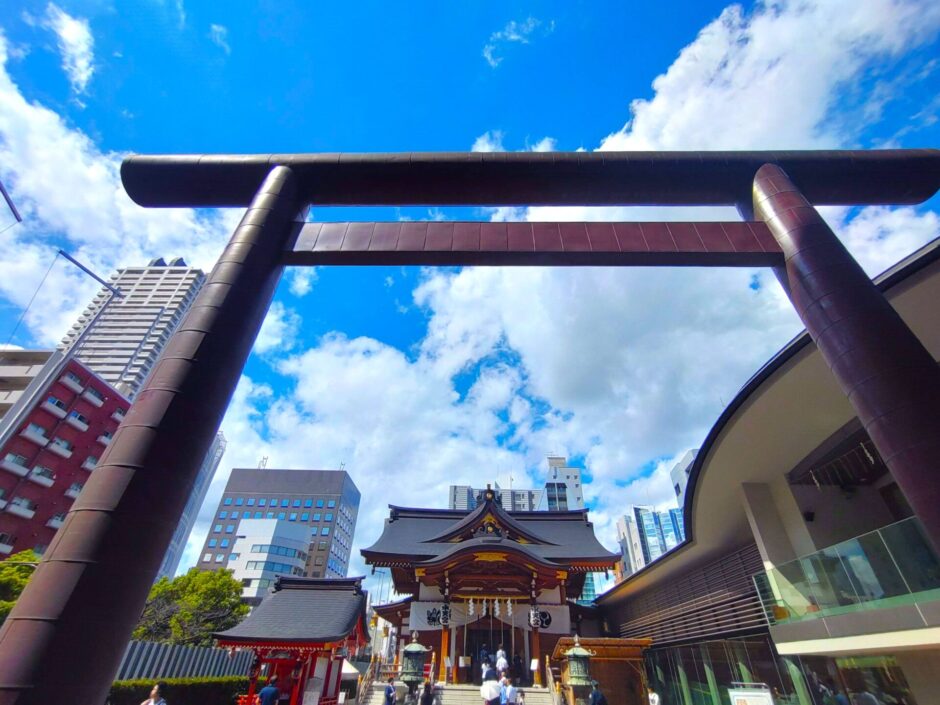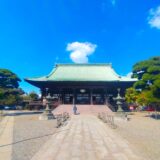【Suitengu summary】
Suitengu was originally built in 1818 by Yorinori Arima (1797 – 1844), lord of the Kurume domain, who invited Kurume Suitengu to his domain residence in Mita-Akabane. The common people of Edo at that time wanted to worship at the Suitengu located in the mansion, so the shrine was opened to them, and pregnant women who visited the shrine had easy childbirth, and the shrine’s reputation spread and became the focus of religious devotion. Later, the Arima family’s mansion was relocated, and in 1872, the shrine was moved to its current location in Nihonbashi Kakigaracho. Today, the shrine is so famous that the Tokyo Metro has a “Suitengumae” stop.
The three ancestral deities of the Japanese Gods, Amenominakanushi no Okami, Emperor Antoku, Kenreimonin, and Niino-Ama, are the deities of the shrine.
【Suitengu newly constructed shrine appearance】
![Suitengu [Tokyo] 26746575 m 1024x683 - Suitengu [Tokyo]](https://japan-shrine.info/wp-content/uploads/26746575_m-1024x683.jpg)
The shrine building was reconstructed as a project to commemorate the 200th anniversary of the Edo Jinja. It was renovated in 2016 due to the fact that it could not accept refugees returning home during the earthquake disaster.
![Suitengu [Tokyo] DSC 1152 1024x740 - Suitengu [Tokyo]](https://japan-shrine.info/wp-content/uploads/DSC_1152-1024x740.jpg)
Since the shrine has been modernized, it no longer has a sense of history or atmosphere. However, we believe that the main purpose of the shrine is to allow worshippers who wish for the safe delivery and growth of their children to visit, receive prayers, and return home in a safe manner. From the entrance, a rather inorganic staircase leads to the torii gate and the main shrine building.
【Suitengu hall of worship】
![Suitengu [Tokyo] DSC 1147 1024x768 - Suitengu [Tokyo]](https://japan-shrine.info/wp-content/uploads/DSC_1147-1024x768.jpg)
The worship hall is new and clean. The site is compact and the population density is rather high, but it is a modern and unusual shrine with seismic isolation.
【Suitengu precincts Bronze statue of a dog, a baby dog】
![Suitengu [Tokyo] DSC 1146 1024x768 - Suitengu [Tokyo]](https://japan-shrine.info/wp-content/uploads/DSC_1146-1024x768.jpg)
The mascot of Suitengu Shrine. It is said to be effective for the healthy growth of children and child bearing when touched. It is said to be good to stroke the zodiac sign of the child to be born.
【Suitengu precincts Hosho Benzaiten】
![Suitengu [Tokyo] DSC 1148 2 1024x768 - Suitengu [Tokyo]](https://japan-shrine.info/wp-content/uploads/DSC_1148-2-1024x768.jpg)
Behind the child treasure dog is the Benzaiten Shrine. Benzaiten is believed to be the god of learning and arts. From New Year’s Day, the area is said to be crowded with people walking around the “Seven Gods of Good Fortune in Nihonbashi,” which consists of seven shrines in the area.
【Suitengu GOSHUIN】
![Suitengu [Tokyo] 2024 10 28 14 13 Office Lens 1024x765 - Suitengu [Tokyo]](https://japan-shrine.info/wp-content/uploads/2024_10_28-14_13-Office-Lens-1024x765.jpg)
【Suitengu Nearby attractions】
Fukutoku Shrine, Koami Shrine, Suehiro Shrine, Matsushima Shrine, Chanoki Shrine, Sugimori Shrine, Kasama Inari Shrine Tokyo Branch, Takarada Ebisu Shrine
【Suitengu Access】
Manager’s Comments
I was surprised at the modern construction. There was a bronze statue of a dog, which made me nostalgic. In honor of the dog, which is light and prolific in childbirth, the shrine is quite crowded every 12 days during the “dog days. The waiting room at the temporary shrine was so cold that once a pregnant woman collapsed and an ambulance was called, but the current waiting room at Shingu is spacious and air-conditioned.
4-1, Nihonbashikakigaracho 2-chome, Chuo-ku, Tokyo 103-0014, Japan
※Paid parking available(1st floor)
 Tour of Japanese shrines and temples
Tour of Japanese shrines and temples 

![Suitengu [Tokyo] DSC 0542 520x300 - Suitengu [Tokyo]](https://japan-shrine.info/wp-content/uploads/DSC_0542-520x300.jpg)
![Suitengu [Tokyo] DSC 1162 2 520x300 - Suitengu [Tokyo]](https://japan-shrine.info/wp-content/uploads/DSC_1162-2-520x300.jpg)
![Suitengu [Tokyo] ac5cd87671e233e71a4d8d3abe60c251 - Suitengu [Tokyo]](https://japan-shrine.info/wp-content/uploads/sng/ac5cd87671e233e71a4d8d3abe60c251.jpg)
![Suitengu [Tokyo] DSC 0545 150x150 - Suitengu [Tokyo]](https://japan-shrine.info/wp-content/uploads/DSC_0545-150x150.jpg)
![Suitengu [Tokyo] DSC 03512 150x150 - Suitengu [Tokyo]](https://japan-shrine.info/wp-content/uploads/DSC_03512-150x150.jpg)
![Suitengu [Tokyo] DSC 1162 2 150x150 - Suitengu [Tokyo]](https://japan-shrine.info/wp-content/uploads/DSC_1162-2-150x150.jpg)
![Suitengu [Tokyo] DSC 1374 150x150 - Suitengu [Tokyo]](https://japan-shrine.info/wp-content/uploads/DSC_1374-150x150.jpg)

